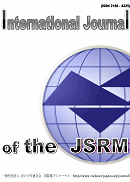This paper is the summary of the paper by the authors (Hashimoto et al. 2021) receiving the best research paper award from the Japanese Society for Rock Mechanics (JSRM). Dynamic analyses of jointed rock masses, such as slope stability evaluations, have been intensively studied in recent years; discontinuous deformation analysis (DDA) is one of the feasible methods in this field. To predict the failure mode, the kinematic energy, and the reaching distance after the collapse, the friction characteristics of the rock joints must be computed correctly. The authors previously developed an improved DDA utilizing an implicit updating scheme of friction along the joints, the so-called return mapping method, which achieved higher accuracy and computational robustness for the dynamic sliding behaviors of rock joints than the conventional method. However, the improved method assumes that the joint friction angle is constant even after the joint fails as same as the original DDA, and this results in an underestimate of sliding displacement. Therefore, in this study, a simple transition algorithm from static to residual friction within the framework of the return mapping method is implemented to reproduce friction strength degradation. The performance of the proposed method is examined through the numerical examples and the improvements in the robustness, accuracy, and computational efficiency for the dynamic sliding problems along the rock joint were confirmed.
View full abstract
